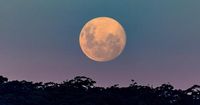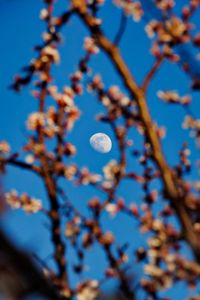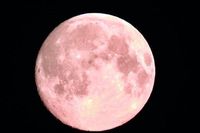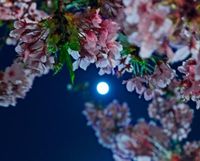Skygazers across the UK are in for a celestial treat this weekend, as the first full moon of spring, known as the "Pink Moon," is set to illuminate the night sky. This year, the Pink Moon also qualifies as a "micromoon," making it the smallest moon of 2025, as it will occur when the moon is at its farthest point from Earth in its orbit.
The Pink Moon will rise on Saturday, April 12, 2025, at approximately 9 PM, reaching its peak illumination at 1:22 AM on Sunday, April 13, 2025. Despite its name, the moon will not actually appear pink; the name originates from Native American traditions, specifically referring to the early spring bloom of wild ground phlox, a pink flower typically found in North America.
According to the Royal Museums Greenwich, in addition to being called the Pink Moon, it is also referred to as the Egg Moon, Sprouting Grass Moon, and Fish Moon. The Egg Moon name relates to the spring season, which is a time when many animals lay eggs. This year, the Pink Moon will shine alongside Spica, a bright blue-white star that marks the heart of the Virgo constellation. Spica is known as the 16th brightest star in the sky, emitting approximately 20,500 times more light than the Sun.
As the Pink Moon rises in the east, it will appear just below Spica, creating a stunning visual display for stargazers. The two celestial bodies will be visible together, with Spica likely shining brightly above the moon. The moon will appear slightly smaller and dimmer than usual due to its status as a micromoon, but this difference is often not noticeable to the naked eye.
The celestial event is set to begin at 9 PM on April 12, with the moon reaching its peak at 1:22 AM on April 13. After this peak, the moon will continue to shine brightly throughout the night and will set around 6 AM on Monday, April 14. If you're planning to catch a glimpse of this lunar spectacle, clear skies will enhance the experience, allowing for a beautiful view.
The Pink Moon is not just a visual delight; it also holds significance in various cultures. In Asia, particularly in China, April's full moon is known as the Peony Moon, named after the blush-colored flowers that bloom at this time. Meanwhile, Native American tribes have various names for the April moon, each reflecting the changes in nature. For instance, the Oglala tribe refers to it as the "Moon of the Red Grass Appearing," while the Tlingit tribe calls it the "Budding Moon of Plants and Shrubs." These names illustrate the connection between the lunar cycle and the natural world.
For those curious about the lunar cycle, a full moon occurs approximately every 29.5 days, when the moon is completely illuminated by the Sun's rays. This alignment happens when the Earth is positioned directly between the Sun and the moon. The Pink Moon marks the first full moon of the official spring season, making it a time of renewal and rebirth.
Following the Pink Moon, several other full moons are scheduled for 2025. The Flower Moon will rise on May 12, followed by the Strawberry Moon on June 11, the Buck Moon on July 10, and the Sturgeon Moon on August 9. Each of these moons carries its own name and significance, often rooted in cultural traditions.
In addition to the Pink Moon, April will also see the annual Lyrid meteor shower, which peaks around April 21-22. This meteor shower is one of the oldest known, with a history dating back over 2,600 years. Stargazers can expect to see up to 15 meteors per hour during this event, making it another exciting opportunity to observe the night sky.
As the Pink Moon and Spica grace the sky, amateur astronomers and casual stargazers alike are encouraged to take a moment to appreciate the beauty of the universe. Whether using binoculars or just the naked eye, the combination of the full moon and the bright star will create a memorable experience.
So, mark your calendars for this weekend and prepare to enjoy the Pink Moon and Spica in all their glory. With a little luck and clear skies, it promises to be a night to remember!









